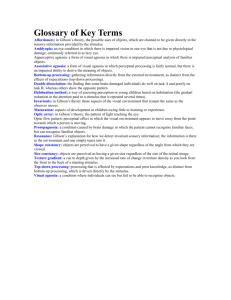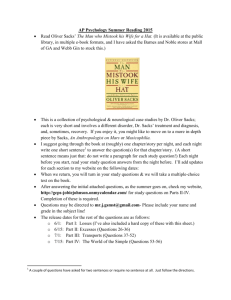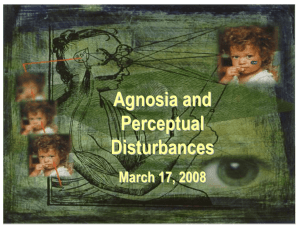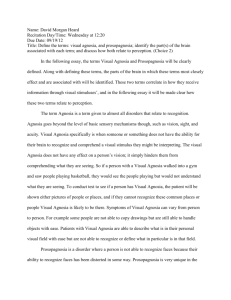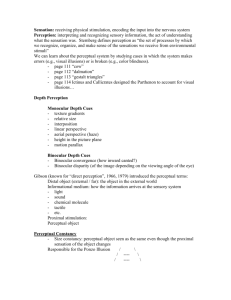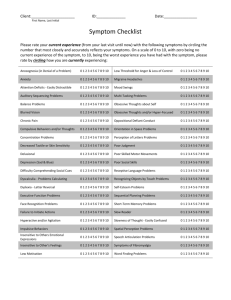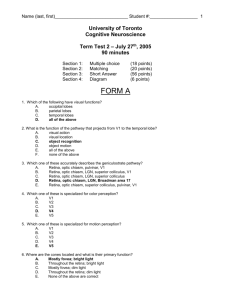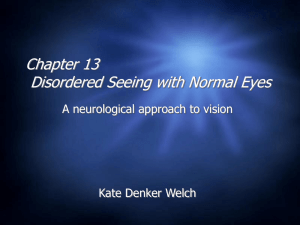Agnosia: Cognitive Primer on Perceptual Disorders
advertisement
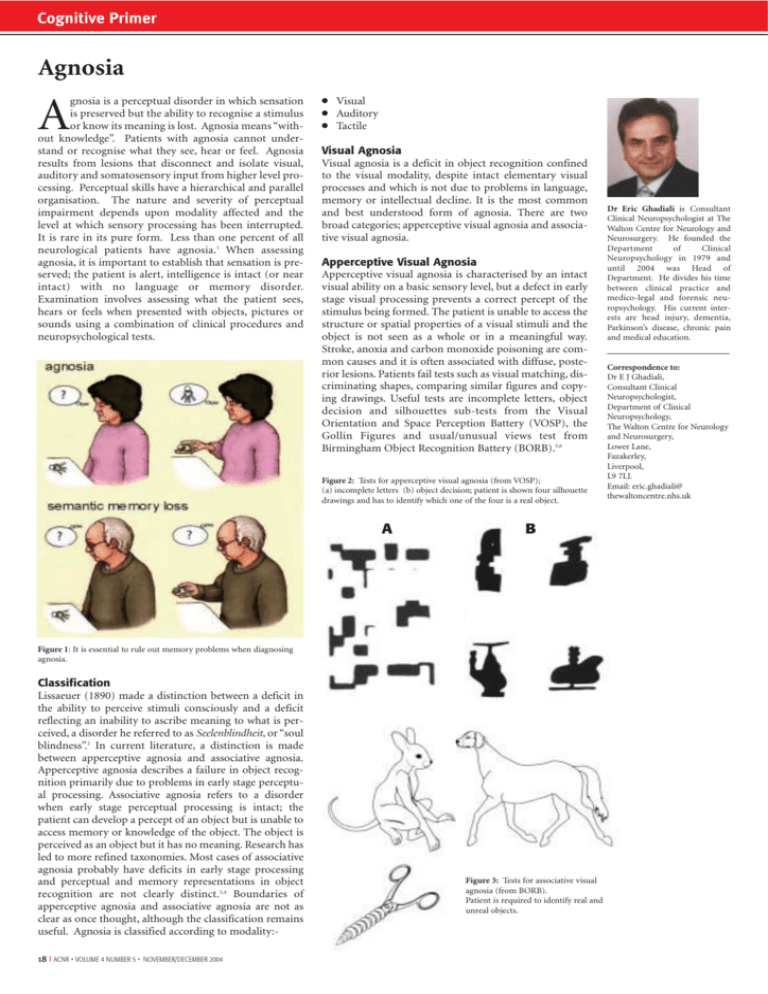
Cognitive Primer Agnosia gnosia is a perceptual disorder in which sensation is preserved but the ability to recognise a stimulus or know its meaning is lost. Agnosia means “without knowledge”. Patients with agnosia cannot understand or recognise what they see, hear or feel. Agnosia results from lesions that disconnect and isolate visual, auditory and somatosensory input from higher level processing. Perceptual skills have a hierarchical and parallel organisation. The nature and severity of perceptual impairment depends upon modality affected and the level at which sensory processing has been interrupted. It is rare in its pure form. Less than one percent of all neurological patients have agnosia.1 When assessing agnosia, it is important to establish that sensation is preserved; the patient is alert, intelligence is intact (or near intact) with no language or memory disorder. Examination involves assessing what the patient sees, hears or feels when presented with objects, pictures or sounds using a combination of clinical procedures and neuropsychological tests. A ● ● ● Visual Auditory Tactile Visual Agnosia Visual agnosia is a deficit in object recognition confined to the visual modality, despite intact elementary visual processes and which is not due to problems in language, memory or intellectual decline. It is the most common and best understood form of agnosia. There are two broad categories; apperceptive visual agnosia and associative visual agnosia. Apperceptive Visual Agnosia Apperceptive visual agnosia is characterised by an intact visual ability on a basic sensory level, but a defect in early stage visual processing prevents a correct percept of the stimulus being formed. The patient is unable to access the structure or spatial properties of a visual stimuli and the object is not seen as a whole or in a meaningful way. Stroke, anoxia and carbon monoxide poisoning are common causes and it is often associated with diffuse, posterior lesions. Patients fail tests such as visual matching, discriminating shapes, comparing similar figures and copying drawings. Useful tests are incomplete letters, object decision and silhouettes sub-tests from the Visual Orientation and Space Perception Battery (VOSP), the Gollin Figures and usual/unusual views test from Birmingham Object Recognition Battery (BORB).5,6 Figure 2: Tests for apperceptive visual agnosia (from VOSP); (a) incomplete letters (b) object decision; patient is shown four silhouette drawings and has to identify which one of the four is a real object. A B Figure 1: It is essential to rule out memory problems when diagnosing agnosia. Classification Lissaeuer (1890) made a distinction between a deficit in the ability to perceive stimuli consciously and a deficit reflecting an inability to ascribe meaning to what is perceived, a disorder he referred to as Seelenblindheit, or “soul blindness”.2 In current literature, a distinction is made between apperceptive agnosia and associative agnosia. Apperceptive agnosia describes a failure in object recognition primarily due to problems in early stage perceptual processing. Associative agnosia refers to a disorder when early stage perceptual processing is intact; the patient can develop a percept of an object but is unable to access memory or knowledge of the object. The object is perceived as an object but it has no meaning. Research has led to more refined taxonomies. Most cases of associative agnosia probably have deficits in early stage processing and perceptual and memory representations in object recognition are not clearly distinct.3,4 Boundaries of apperceptive agnosia and associative agnosia are not as clear as once thought, although the classification remains useful. Agnosia is classified according to modality:18 I ACNR • VOLUME 4 NUMBER 5 • NOVEMBER/DECEMBER 2004 Figure 3: Tests for associative visual agnosia (from BORB). Patient is required to identify real and unreal objects. Dr Eric Ghadiali is Consultant Clinical Neuropsychologist at The Walton Centre for Neurology and Neurosurgery. He founded the Department of Clinical Neuropsychology in 1979 and until 2004 was Head of Department. He divides his time between clinical practice and medico-legal and forensic neuropsychology. His current interests are head injury, dementia, Parkinson’s disease, chronic pain and medical education. Correspondence to: Dr E J Ghadiali, Consultant Clinical Neuropsychologist, Department of Clinical Neuropsychology, The Walton Centre for Neurology and Neurosurgery, Lower Lane, Fazakerley, Liverpool, L9 7LJ. Email: eric.ghadiali@ thewaltoncentre.nhs.uk Cognitive Primer Associative Visual Agnosia In associative visual agnosia, primary sensory and early visual processing systems are preserved. The patient can perceive objects presented visually but cannot interpret, understand or assign meaning to the object, face or word. Associative visual agnosia is usually the result of bilateral damage to the inferior temporo-occipital junction and subjacent white matter. The cause is most often infarction of the posterior cerebral artery bilaterally. Other causes include tumour, haemorrhage and demyelination. It is more common than apperceptive visual agnosia. Common sub-types are:● Visual object agnosia Patients are able to copy objects and pictures, often with great accuracy, but do not recognise the objects or understand what they have drawn. This can be assessed by presenting the patient with pictures of objects and asking them to name, describe functions and sort according to use or category to which they belong. Analysis of errors will enable the examiner to exclude anomia and semantic memory problems, both of which can cause naming and recognition problems. For example, a patient with visual object agnosia will be unable to name or recognise a picture of a kangaroo. The same patient will have no difficulty naming and describing the characteristics of a kangaroo if requested via the auditory modality. Patients with anomia will be unable to name the picture and may respond, “it’s found in Australia, it jumps…can’t think of its name,” demonstrating intact recognition. Patients with semantic dementia have central loss of knowledge and will be unable to name the picture or demonstrate any knowledge of the object regardless of modality. The Graded Naming Test provides a source of pictures of objects from different categories.7 Useful tests are the real/unreal object test from the Birmingham Object Recognition Battery and The Pyramid and Palm Trees test, a matching test that requires the patient to select one of two pictures connected with the target picture.8 Verbal content is minimal making it suitable for patients with aphasia. may appear blind, bumping into walls and furniture, making haphazard and uncoordinated movements in attempting to reach for objects. If asked to focus on a small visual area, the patient may describe this accurately and in great detail. ● Category specific agnosia Impaired recognition of objects within a certain category.9 Studies have reported selective recognition deficits in categories including animate vs. non-animate, living vs. nonliving, metals, fruit, vegetables and musical instruments. Artefacts caused by poor matching of picture sets on variables such as familiarity, task difficulty and complexity complicate interpretation.10 ● Prosopagnosia Prosopagnosia is a disorder of face recognition. Patients can identify facial parts, recognise a face as a face but with no recognition of the person. In severe cases, patients cannot recognise their own face. Affected people can use cues such as hairstyle, glasses and clothing and will recognise the person as soon as they speak. It can be acquired or developmental. Lesions causing prosopagnosia usually occupy the bilateral inferomesial visual association cortices and subjacent white matter. Prosopagnosia may occur in isolation suggesting that there are specific areas of the brain that process visual information pertaining to face recognition. Disorders in face recognition can be assessed with the Benton Facial Recognition test and informally using photographs of well-known politicians and celebrities, ensuring that the photographs are culturally and age appropriate.11,12 The ability to recognise emotional expression may be dissociated from the ability to identify faces. Deficits in recognition of facial emotional expression have been reported following amygdalectomy.13 Figure 5: Region of brain lesions (shaded area) in a patient with prosopagnosia. Figure 4: Pyramids and Palm Trees Test. Assesses ability to access meaning from words and pictures. ● Simultanagnosia Simultanagnosia is characterised by an inability to perceive more than one aspect of a visual stimulus and to integrate visual detail into a coherent whole. For example, if a patient with simultanagnosia is asked to name a picture of spectacles, they may respond “there is a circle, another circle, it is joined by a cross piece – it must be a bicycle!” If the same task was given to a patient with severe apperceptive visual agnosia, the patient would be unable to perceive the constituents of the picture such as the circle. Balint’s syndrome is a rare disorder consisting of the triad of simultanagnosia, gaze apraxia, and optic ataxia. It is caused by bilateral occipitoparietal lesions. The patient ● Pure alexia Also known as alexia without agraphia or pure word blindness. Pure alexia is a perceptual disorder causing impairment in reading words and letters. The patient can copy words and letters and in the act of copying the words or tracing out the letters will recognise the word or letter. The patient can write to dictation but is unable to read back what has been written. ACNR • VOLUME 4 NUMBER 5 • NOVEMBER/DECEMBER 2004 I 19 Cognitive Primer Figure 6: Patients with damage to the amygdala have difficulties in recognising emotion from facial expression. taneously, follow written commands but cannot write to dictation and are impaired on word repetition tasks. It is caused by lesions that disconnect Wernicke’s area from auditory input. ● Amusia Impairment in musical expression or perception. It is highly dependent upon culture, environment and individual experience and may be unnoticed. There is a loss in the ability to sing, hum or whistle and no recognition or emotional response to music. Anatomical correlates are multiple. Patients with aphasia can often sing and this supports a role of the right hemisphere in musical expression. Assuming the examiner has the necessary musical skill, it can be assessed informally by humming or whistling familiar melodies such as “Happy Birthday” or by using formal tests.14 Figure 7: A sheep farmer with prosopagnosia failed a facial recognition test in which he had to identify a familiar face (Norman Tebbit) from unfamiliar faces. In contrast, he was able to recognise familiar and unfamiliar sheep.16 ● Colour agnosia Loss of colour knowledge. Patients find it difficult to colour black and white drawings of objects. For example, they may colour an apple blue. Auditory agnosia Inability to appreciate meaning of sound despite normal perception of pure tones. Non-verbal and verbal forms may exist independently or may co-exist. Audiological assessment is required. ● Non-verbal auditory agnosia Impaired understanding and recognition of non-linguistic sounds such as bells, whistles or animal noises. It is associated with right temporal or parietal lobe lesions or bilateral lesions of the auditory association cortex. ● Pure word deafness Inability to comprehend spoken language despite normal hearing and no aphasia. Patients can copy and write spon- References 1. Zihl J, Kennard C. Disorders of higher visual functions. In Neurological disorders, course and treatment (eds. Brandt T, Caplan LR, Dichgans J, Diener HC Kennard C) 1996;201-12. Academic Press, San Diego. 2. Lissauer H. Ein Fall von Seelenblindheit nebst einem beitrage zue Theorie derselben. Archiv fur Psychiatrie und Nervenkrankheiten 1890; 21:22-270. English translation by Jackson M. Lissauer on agnosia. Cognitive Neuropsychology 1988;5:155-192. 3. Riddoch MJ, Humphreys GW. Object recognition. In B. Repp (Ed.), The Handbook of Cognitive Neuropsychology: What Deficits Reveal about the Human Mind, 2001 pp. 45-74. Philadelphia: Psychology Press. 4. Farah MJ. Visual agnosia. MIT Press, Cambridge, MA 1990. 20 I ACNR • VOLUME 4 NUMBER 5 • NOVEMBER/DECEMBER 2004 Tactile agnosia Selective impairment of object recognition by touch despite relatively preserved primary and discriminative somesthetic perception. It is a unilateral disorder usually resulting from lesions of the contralateral inferior parietal cortex. The ability to recognise basic features such as size, weight and texture may be dissociated from the ability to name or recognise the object.15 Treatment and recovery In the early stages of recovery, lack of awareness of the deficit, anosognosia, may lead to therapeutic resistance. Partial recovery is more likely in traumatic and vascular lesions and less likely in anoxic brain damage due to widespread diffuse lesions and additional cognitive impairment impeding acquisition of compensatory strategies. Controlled treatment studies are rare. Many case reports show improvement following intensive rehabilitation. Principles of treatment are restitution, repetitive training of impaired function, and compensation, with utilisation of spared function to compensate for the deficit. 5. Warrington EK, James M. Visual Object and Space Perception Battery (VOSP). Thames Valley Test Company, Bury St Edmunds 1991. 6. Riddoch MJ, Humphreys GW. Birmingham Object Recognition Battery (BORB). Lawrence Erlbaum Associates, Hove, East Sussex 1993. 7. McKenna P. The Category-Specific Names Test. Psychology Press, Hove, East Sussex 1997 8. Howard D, Patterson K. The Pyramids and Palm Trees Test. Thames Valley Test Company, Bury St Edmunds 1992. 9. Warrington EK, Shallice T. Category Specific Semantic Impairments. Brain 1984; 107:829-854. 10. Takarae Y, Levin DT. Animals and Artifacts May Not Be Treated Equally: Differentiating Strong and Weak Forms of Category-Specific Visual Agnosia. Brain and Cognition 2001; 45:246-264. 11. Benton AL, Hamsher, K deS, Varney NR, Spreen O. Contributions to neuropsychological assessment. New York: Oxford University Press, 1983. 12. Warrington EK. Recognition memory test. Windsor: NFER-Nelson 1984. 13. Adolphs R. Recognising emotion from facial expressions: Psychological and neurological mechanisms. Behavioural and Cognitive Neuroscience Reviews 2002; 1: 21-61. 14. Peretz I, Champod AS, Hyde K. Varieties of musical disorders. The Montreal Battery of Evaluation of Amusia. Ann N Y Acad Sci. 2003; Nov: 999:58-75. 15. Reed CL, Caselli RJ, Farah, MJ. Tactile agnosia: underlying impairment and implications for normal tactile object recognition. Brain 1996; 119:875-88 16. McNeil M, Warrington EK. Prosopagnosia: A face-specific disorder. Q J Exp Psychol 1993;46:1-10.
